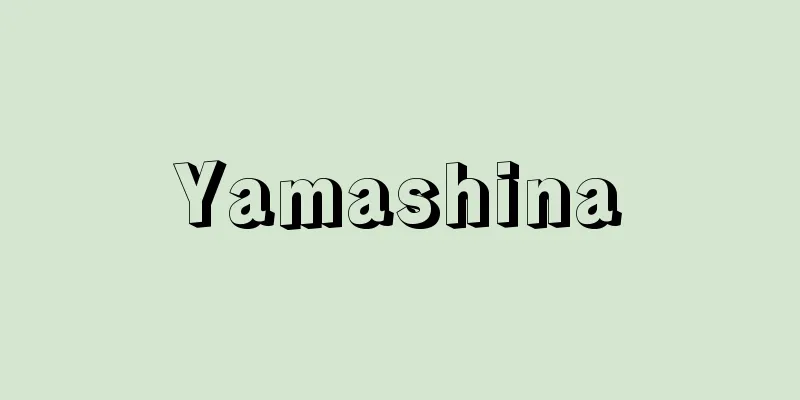Yamashina

|
The ancient name for the Yamashina Basin, located in the northern part of Uji County, Yamashiro Province, and in the eastern part of present-day Kyoto City. It is roughly the same as the Yamashina area of Kyoto City. In ancient times, the Yamashina Basin had three districts: Yamashina, Ono, and Amarube (Wamyo-sho), but by the mid-12th century, the Ono and Amarube areas were also included in the name Yamashina. During the Heijo-kyo period, the Hokuriku Road (which roughly corresponds to the later Nara Kaido) passed through the area, and Yamashina Station was established there (it was discontinued in 804). After the construction of Heian-kyo, it became a key point on the Tokaido. In the southern part of the basin, in Nishinoyama, there is a place called Nakatomi, where a complex archaeological site from the Jomon to Heian periods, the Nakatomi Ruins, is located. The center of the site is the remains of a settlement from around the time of the appearance of the Kofun burial mounds and in the late Kofun period, and it has been pointed out that there is a connection with the ancient powerful Nakatomi clan. The Nakatomi clan lived in Yamashina from early times, and Nakatomi Kamako (Fujiwara Kamatari) had a mansion there called Suehara-yakata. This mansion became Yamashina-shoja, and later developed into Nara Kofuku-ji (also known as Yamashina-dera). Prince Nakano Oe (Emperor Tenchi) established Otsu-kyo (Omi-Otsu Palace) in Omi, adjacent to Yamashina, in 667, likely because he relied on the influence of the Nakatomi clan in Yamashina. Emperor Tenchi was buried in Yamashina (Yamashina Mausoleum of Emperor Tenchi). After the capital was moved to Yamashina in the Heian period, the area was developed into a strategic location in the suburbs, and many temples were built there. Among them, Anjo-ji, Gangyo-ji, Kanshu-ji, and Zuishin-in were highly ranked and influential, and were deeply involved in the history of Yamashina until later times. In 1167, Emperor Goshirakawa built the "Yamashina New Imperial Palace" at Yamashina Oyake, and the Imperial Palace and its surrounding territories were passed down to his favorite concubine, Tango no Tsubone Takashina Eishi, and then to her son Reizei (Yamashina) Nori Shige, and most of Yamashina was the Imperial Household's main residence, and the Yamashina family held the position of lord, and it continued to exist as the Imperial Household's Yamashina Ono Manor (Yamashina Manor). After the Nanboku-cho period, the area was reorganized to form villages collectively known as the "Yamashina Seven Villages," but the ownership relationship remained unchanged, and from the Muromachi period to the Sengoku period, the Imperial Court's levies on the Yamashina Seven Villages and the Shogunate's orders were handled through the Yamashina family. Another notable feature of Yamashina in the Middle Ages is the construction of Yamashina Hongan-ji Temple by Rennyo in 1478. Until it burned down in 1532, the temple and the town within the temple flourished as a base for the Jodo Shinshu Hongan-ji sect. Earthworks and other structures remain, and Rennyo's grave is in one corner. In the early modern period, the villages were no longer under the control of the Yamashina family, but most of them (17 villages, over 6,000 koku) were imperial property (Imperial property). Although the autonomous association disappeared, the organization of the Seven Yamashina Villages was inherited, and the close relationship with the imperial family continued, with samurai serving the Imperial Palace on various occasions and bearing various burdens. During the late Edo period and the Meiji Restoration, they played various roles on the side of the Imperial Court. Yamashina Village was established in 1889, town status was implemented in 1926, and it became part of Higashiyama Ward in Kyoto City in 1931, but was separated as Yamashina Ward in 1976. → Related article Shinomiyagawara Source : Heibonsha Encyclopedia About MyPedia Information |
|
山城国宇治郡の北部,現在の京都市東部にある山科盆地一帯をさす古代以来の地名。ほぼ同市山科区域にあたる。古代の山科盆地には山科・小野・余部(あまるべ)の3郷があったが(《和名抄》),12世紀半ばころまでに小野・余部地域をも含めて山科とよぶようになった。平城京の時代には北陸道(のちの奈良街道にほぼ合致)が通って山科駅が置かれ(804年停止),平安京造営後は東海道の要衝となる。盆地の南部,西野山(にしのやま)に中臣(なかとみ)の地名があり,縄文時代から平安時代までの複合遺跡〈中臣遺跡〉が所在する。遺跡の中心は古墳出現期前後および古墳時代後期の集落跡で,古代豪族中臣氏との関連が指摘されている。中臣氏は早くから山科に住み,中臣鎌子(藤原鎌足)は当地に陶原(すえはら)館とよばれる邸宅を構えていた。この館が山科精舎となり,のちに奈良興福寺(別名山階寺)へと発展した。中大兄(なかのおおえ)皇子(天智天皇)が667年山科に隣接する近江に大津京(近江大津宮)を営んだのも,山科における中臣氏の勢力をたのんでのことであろう。天智天皇は山科に葬られている(天智天皇山科陵)。平安遷都後は近郊の要地として開けていき,寺院が多く建立された。なかでも安祥寺,元慶(がんぎょう,がんけい)寺,勧修(かんしゅう)寺,随心(ずいしん)院などは寺格も高く勢力を誇り,のちの時代まで山科の歴史に深くかかわった。1167年山科大宅(おおやけ)に後白河上皇が〈山科新御所〉を造営,御所とその周辺所領が同上皇の寵妃(ちょうひ)丹後局高階栄子(たかしなえいし)を経てその子冷泉(山科)教成(のりしげ)に伝領され,山科の大部分は皇室を本所とし,山科家が領家職をもつ皇室領山科小野荘(山科荘)として推移する。南北朝期以降は再編されて〈山科七郷〉と総称される郷村が形成されるが,領有関係に変化はなく,室町時代から戦国時代にかけて,朝廷の山科七郷への賦課や幕府の命は,山科家を通じて処理されている。中世期の山科でいまひとつ特記すべきことは,1478年の蓮如による山科本願寺の建立で,1532年に焼亡するまで本願寺とその寺内町は,浄土真宗本願寺派の拠点として栄えた。今も土塁などが残り,一角に蓮如の墓がある。近世には山科家の支配を離れるが,ほとんどの村(17村・6000余石)は皇室領(禁裏御料)であった。自治的結合は消滅したが山科七郷の組織はうけつがれ,皇室との密接な関係は継続し,ことあるごとに郷士が御所に勤仕し,諸種の負担をも負った。幕末・維新期には朝廷方についてさまざまに活躍している。1889年山科村が成立,1926年町制施行,1931年京都市東山区の一部となるが,1976年山科区として分離。 →関連項目四宮河原 出典 株式会社平凡社百科事典マイペディアについて 情報 |
Recommend
Reformed Churches English
In a broad sense, it refers to the Protestant chu...
Chondrodite
...A general term for the four rock-forming miner...
Cut; section
In mathematics, the word cut is used in the follow...
Multiple sclerosis
Concept Multiple sclerosis is the most common demy...
Professions
…It refers to private practice doctors, lawyers, ...
Mount Yonaha
Located in Kunigami Village in the northern part ...
Takaomi Ume - Baigyoshin
A poet of the Northern Song Dynasty in China. Born...
Akashi Park - Akashi Park
(Akashi City, Hyogo Prefecture) A tourist attracti...
Military intelligence
Information used by the military. However, these t...
Libel law - Zambouritsu
Japan's first independent libel law was promu...
Bathing dress
…It is also called a sea swimsuit. In English it ...
France Antarctique (English)
...There are many world-famous beaches such as Co...
marquis
… [Europe] The nobility of ancient Rome did not h...
Nursing intervention
...By meeting the needs of the patient in accorda...
Greek Music
Here, Greek music will be described separately fo...









